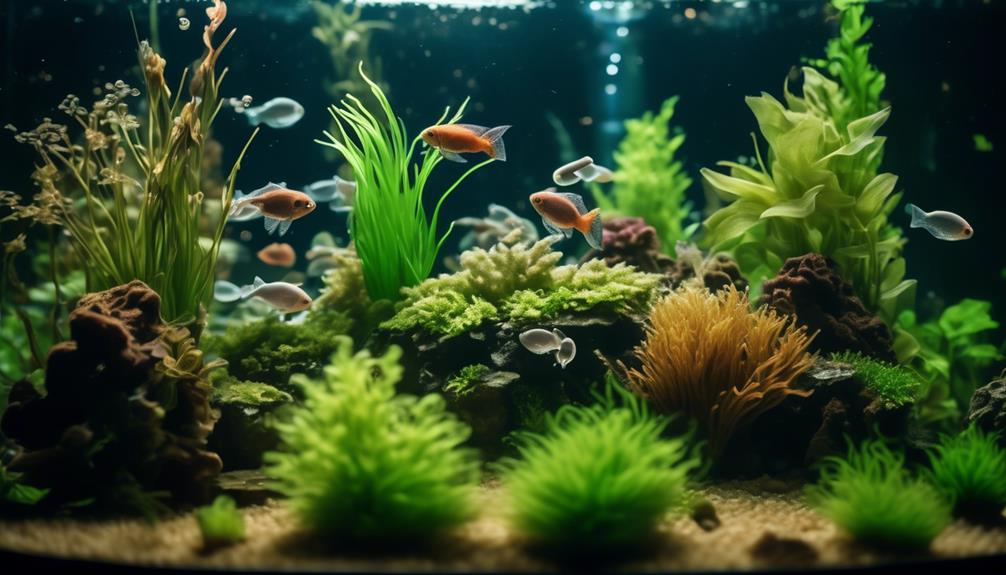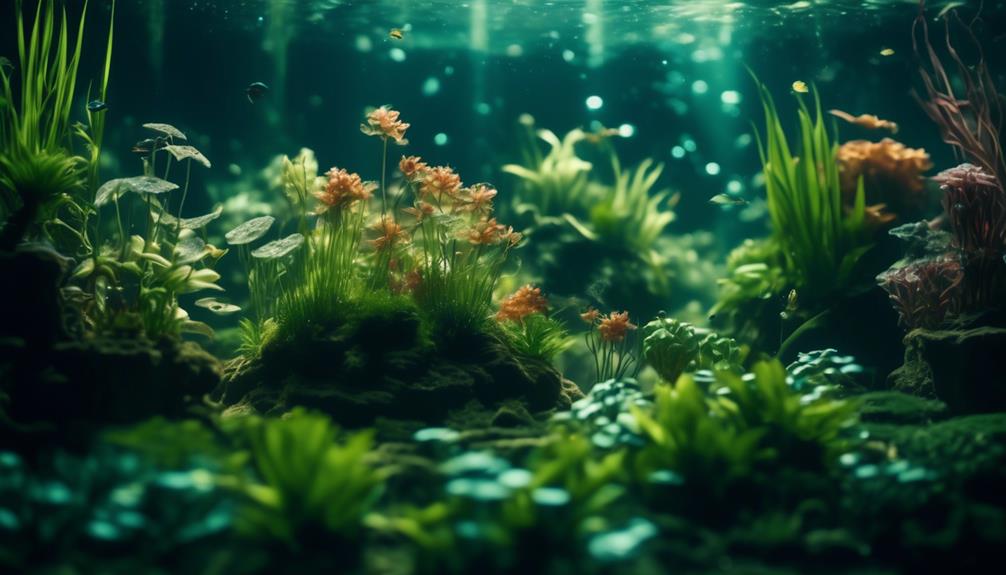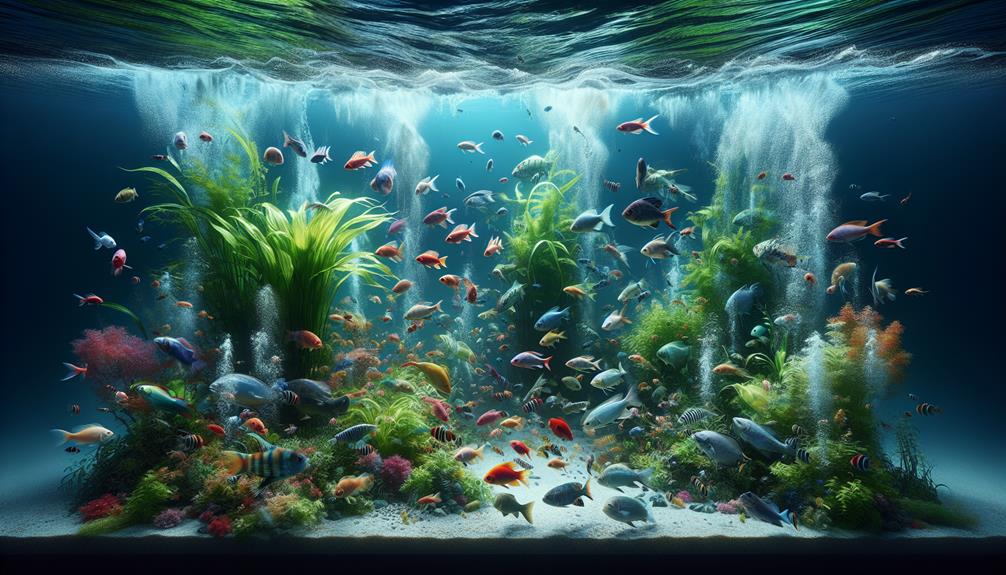Nitrate, a common byproduct in aquariums, may seem harmless at first glance. However, its hidden dangers pose a significant threat to the delicate balance of aquatic ecosystems. While not as toxic as ammonia, high levels of nitrate can have detrimental effects on the well-being of aquarium inhabitants.
The insidious nature of nitrate lies in its elusive nature – colorless and odorless, it can easily go unnoticed without proper testing. As we delve into the intricacies of nitrate and its impact on aquatic life, we will uncover the importance of maintaining safe levels, explore methods to lower nitrate in high bioload tanks, and learn how proper fertilization can help sustain a healthy aquarium environment.
But be warned, the hidden dangers of nitrate may surprise you and leave you eager to discover more.
Key Takeaways
- Nitrate is produced in aquariums as a byproduct of beneficial bacteria breaking down ammonia.
- Nitrate can be harmful to animals in high amounts, although it is less toxic than ammonia.
- Nitrate levels should be kept below 80-100 ppm in fish tanks to ensure the safety of aquatic life.
- Nitrate is essential for the growth of live aquarium plants, and maintaining a nitrate level of around 50 ppm is beneficial for their health.
Understanding Nitrate
Nitrate is a byproduct of beneficial bacteria breaking down ammonia in aquariums. It is important for aquarium owners to understand the significance of water testing and the impact of nitrate on fish health.
Nitrate, although less toxic than ammonia, can still have negative effects on animals if present in high amounts. However, nitrate is colorless and odorless, making it undetectable without water testing. Water test strips or kits can be used to measure nitrate levels, as it cannot be detected with the naked eye.
Safe Levels of Nitrate
Understanding the potential risks associated with high nitrate levels is crucial for maintaining a healthy aquarium environment for your fish. Nitrate, although less toxic than ammonia or nitrite, can still have negative implications on aquatic life if present in high amounts. Regular nitrate testing in aquariums is of utmost importance to ensure that nitrate levels are within safe limits.
To give you an idea of safe nitrate levels, here is a table outlining the recommended concentrations:
| Nitrate Level | Implications on Aquatic Life |
|---|---|
| Below 10 ppm | Optimal for most fish |
| 10-30 ppm | Generally safe, but monitor |
| 30-50 ppm | Suitable for live aquarium plants |
| Above 50 ppm | Can lead to algae growth and stress fish |
Lowering Nitrate in High Bioload Tanks

To effectively reduce nitrate levels in high bioload tanks, implementing strategies such as partial water changes and optimizing the aquarium's ecosystem can be beneficial.
Here are five methods that can help lower nitrate in high bioload tanks:
- Partial water changes: Removing 30-50% of the old water and replacing it with fresh water using an aquarium siphon can quickly lower nitrate levels.
- Adding live plants: Live aquarium plants can absorb nitrate from the water as a nutrient for their growth, thus reducing nitrate levels.
- Optimizing the aquarium's ecosystem: Maintaining a balanced ecosystem with a healthy population of beneficial bacteria can help convert nitrate into harmless nitrogen gas.
- Reducing fish population: High bioload tanks with excessive fish can lead to elevated nitrate levels. By reducing the number of fish, the production of nitrate can be decreased.
- Using nitrate removers: Nitrate removers, such as specialized filter media or chemical additives, can be effective in reducing nitrate levels in high bioload tanks, but their effectiveness may vary.
Fertilization for Aquarium Plants
Aquarium plants require proper fertilization to ensure healthy growth and prevent nutrient deficiencies. Fish waste and uneaten food do not provide all the necessary nutrients for plant growth, making fertilization essential.
One recommended fertilizer for aquarium plants is Easy Green, an all-in-one fertilizer designed to provide the essential nutrients needed for plant health. Easy Green raises nitrate levels to around 50 ppm, which is beneficial for plant growth. It ensures that plants receive the right mix of nutrients, preventing common nutrient deficiencies in aquatic plants.
Maintaining an ideal nitrate concentration is important for plant health, as nitrogen deficiency can cause yellowing or translucent leaves. By dosing Easy Green according to instructions and regularly testing nitrate levels, aquarium plants can thrive and display vibrant, healthy growth.
Maintaining Nitrate Levels for Aquatic Plants

Maintaining the appropriate nitrate levels is crucial for promoting optimal growth and health in aquatic plants. To ensure the well-being of your plants, it is important to regularly test the nitrate levels in your aquarium water. Nitrate serves as a vital source of nitrogen for plants, and a deficiency can lead to yellowing or translucent leaves.
To maintain the ideal nitrate concentration, follow these steps:
- Conduct regular water testing to monitor nitrate levels and make necessary adjustments.
- Keep in mind the role of nitrogen deficiency in plant health and strive for a nitrate level of around 50 ppm.
- Perform a 50% water change if nitrate levels are too high, reducing the concentration.
- Dose 1 pump of Easy Green per 10 gallons of water to increase nitrate levels if needed.
- Adjust fertilizer dosing accordingly based on nitrate test results to prevent deficiencies or excess.
Frequently Asked Questions
Can Nitrate Be Harmful to Humans if Present in an Aquarium?
Nitrate can be harmful to humans if present in high levels in an aquarium. Nitrate toxicity can lead to health risks such as methemoglobinemia, a condition that affects the blood's ability to carry oxygen. Regular testing and maintenance are essential to ensure safe nitrate levels.
How Often Should Nitrate Levels Be Tested in an Aquarium?
Nitrate levels should be tested regularly in aquariums to ensure the health and safety of aquatic life. Signs of high nitrate levels include poor water quality, algae growth, and stressed or sick fish.
Are There Any Other Methods Besides Water Changes to Lower Nitrate Levels?
Alternative methods for nitrate removal include the use of specialized nitrate-removing filter media, such as resins or zeolite, which can selectively absorb and remove nitrate from aquarium water. These methods can be effective in reducing nitrate levels without relying solely on water changes.
Can Nitrate Levels Affect the Ph Balance of the Aquarium Water?
Nitrate levels do not directly affect the pH balance of aquarium water. However, high nitrate levels can contribute to excessive algae growth, while prolonged exposure to elevated nitrate levels can negatively impact fish health.
Is It Possible to Have Too Low Nitrate Levels in an Aquarium With Live Plants?
Yes, it is possible to have too low nitrate levels in an aquarium with live plants. Nitrate deficiency can hinder plant growth and lead to yellowing or translucent leaves. Nitrate supplementation is important to maintain optimal plant health and growth.
Conclusion
In conclusion, nitrate is a commonly overlooked threat in aquariums that can have negative effects on aquatic animals. Proper testing and monitoring of nitrate levels are crucial to ensure the health and vitality of the aquatic ecosystem.
It is important to maintain safe levels of nitrate below 80-100 ppm in fish tanks and around 50 ppm for optimal growth of live aquarium plants.
Taking steps such as partial water changes and introducing live plants can help lower nitrate levels and provide long-term solutions.

